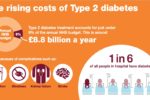Today, many people with type 2 diabetes who need insulin have their insulin initiated in primary care. Here we discuss NICE recommendations for initiation and management of insulin, and the different types of insulin and delivery systems.

Today, many people with type 2 diabetes who need insulin have their insulin initiated in primary care. Here we discuss NICE recommendations for initiation and management of insulin, and the different types of insulin and delivery systems.
The most effective means of reducing the risk of complications associated with type 2 diabetes is to ensure that each patient achieves and maintains their individualised glycaemic target. New guidance from the National Institute for Health and Clinical Excellence (NICE) providesrecommendations on using liraglutide (Victoza), a new option for patients who do not achieve target HbA1c using currently available therapies.
What is important when a nurse and patient are together in a consultation? Most of us have had consultations where the discussion did not appear to achieve anything, while, on other occasions, both parties seemed to be working well together. This article looks at how to share the process of planning treatment with a patient to improve health outcomes; it examines what concordance is, and how to achieve it, looking at how this might work out in practice.
Patients with type 2 diabetes and metabolic syndrome – management recommendations for reducing cardiovascular risk – Richard Hobbs, Eleanor McGregor, John Betteridge
Diabetes mellitus, in particular type 2 diabetes but also type 1 diabetes after the age of 40, confers substantial cardiovascular risk. In people with diabetes, at least in those who have had the disease for a few years, and no history of coronary heart disease, the risk of myocardial infarction is similar to that in non-diabetic patients with manifest cardiovascular disease. Intensive management of cardiovascular risk factors is, therefore, widely recommended for individuals with diabetes.
The recommendation by the National Institute for Health and Clinical Excellence (NICE)1 that men with type 2 diabetes should be assessed annually for erectile dysfunction (ED) may have far-reaching implications. Unfortunately, this is the only significant piece of NICE guidance not yet introduced into the GP Quality and Outcomes Framework (QOF) for 2010.1,2 Although NICE incorrectly classified ED as a neuropathic complication of type 2 diabetes (T2D) rather than a macrovascular, microvascular, endocrine and neuropathic process, the implication of the suggested full assessment of these men is important.
An understanding of evidence-based medicine and how to implement it in clinical practice is now crucial for all professionals involved in the delivery of healthcare. New evidence-based publications are constantly being developed to meet health professionals’ needs for clear, concise and up-to-date information.
In this issue we will review the United Kingdom Prospective Diabetes Study (UKPDS) 38 and the Collaborative Atorvastatin Diabetes Study (CARDS) using the ‘At-A-Glance’ format, as below:
A AcronymT Title and reference
A Aim and introduction
G GroupL Limb and endpointsA Absolute riskN Number needed to treat (NNT)C Clinical conclusionE Education for patient
People with type 2 diabetes are at an increased risk of cardiovascular disease (CVD), and management of diabetic dyslipidaemia is an essential part of diabetes management. The Joint British Societies’ 2 (JBS2) guidelines established the lipid targets of 4 mmol/L for total cholesterol and 2 mmol/L for LDL-cholesterol for people with type 2 diabetes and those with CVD. These lower targets for people with CVD were adopted by the NICE lipid modification guideline (CG67) in 2008, and the new NICE guideline for the management of type 2 diabetes continues this emphasis on lower lipid targets.
Modern treatments available to people with diabetes enable the 1.3 million living with the condition in England alone to minimise and control its impact on their daily lives like never before. But what happens when a person with diabetes develops intercurrent illness, such as a cold or flu? We review the steps to take to ensure that these patients maintain good glycaemic control throughout the ups and downs of other health challenges.

*The British Journal of Primary Care Nursing approached Abbott Healthcare Products Limited to fund the production of this supplement. The company was not involved in its development, although it was asked to review it for technical accuracy just prior to printing. Editorial control has remained with the British Journal of Primary Care Nursing at all times.
A unique new e-platform for primary care

For healthcare professionals in countries with applicable health authority product registrations. The content may not be approved for use in your specific region or country. Please review the applicable product labelling for your country for indications and instructions prior to use. If not approved, please exit this site.
We use cookies to ensure that we give you the best experience on our website.
By continuing to this site you are confirming that you are a healthcare professional and are opting into the use of cookies.
Yes, proceed to the site



















